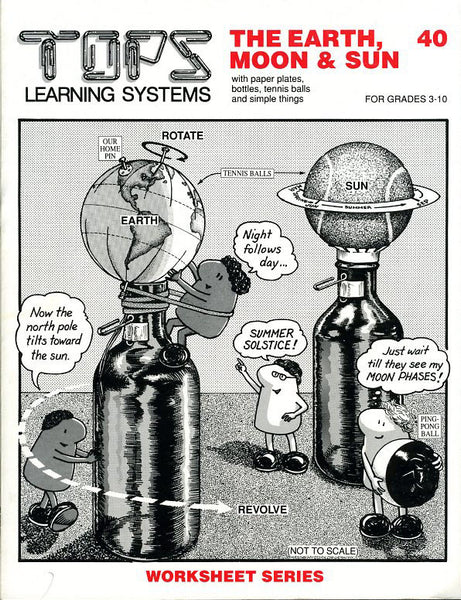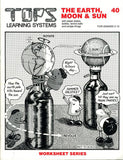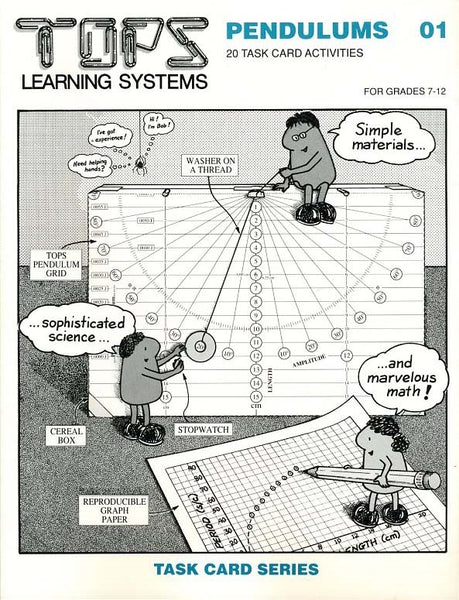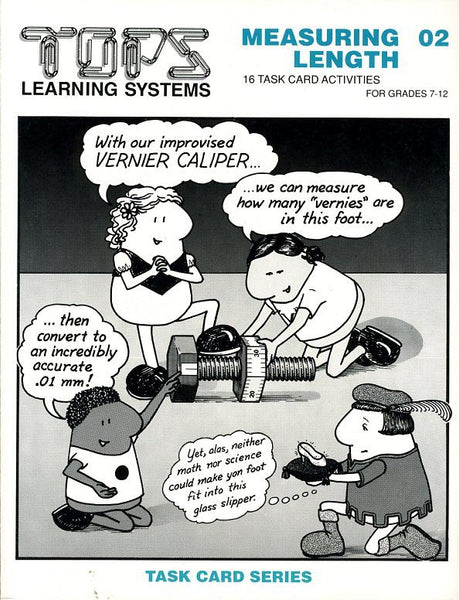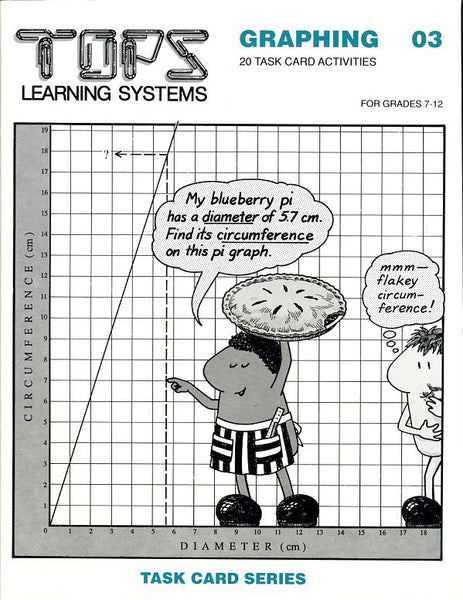#40 The Earth Moon and Sun (grades 5-12)
Regular price $23.95
Soft-bound, 72 page book, 20 reproducible activity sheets, full teaching notes.
Improvise compasses and quadrants to track the sun and moon across a graph paper sky. Cover a tennis ball in a beautiful earth wrapper, then tilt it towards a tennis-ball sun to comprehend seasons. Wrap a Ping-Pong ball halfway in black tape to model moon phases that wax and wane. Fathom heavenly motions indoors and out!
More Information – click any of the tabs below to learn more about this title
Click here for a complete list of materials and convenient shopping.
Key: (1st/2nd/3rd) denote needed quantities: (1st) enough for 1 student doing all activities; (2nd) enough for 30 students working in self-paced pairs; (3rd) enough for 30 students working in pairs on the same lesson. Starred* items may be purchased below.
* 1/1/1: package of steel pins, 1 inch long
* 1/1/1: spool of thread
1/15/15: scissors
* 1/15/15: ceramic magnets
* 1/35/35: small baby food jars or equivalent
1/1/1: water source (a pitcher of water)
* 3/35/35: straight plastic drinking straws
* 0.1/1/1: cups oil-based modeling clay
5/62/62: index cards, 4x6 inch
* 1/10/15: rolls clear tape
1/1/1: roll double-stick clear tape, adhesive on both sides (optional)
* 1/10/15: rolls masking tape
1/1/1: pencil sharpener
* 3/75/75: generic paper plates
* 1/30/30: medium-sized washers
1/8/15: textbooks
1/15/15: wristwatches
7/60/110: medium cans of equal diameter (or paper towel tubes or gift-wrap tubes)
0.5/7/7: quarts dry gravel or sand
3/3/3: full-sized newspaper sheets
1/8/15: meter sticks
1/8/15: hand calculators (optional)
* 1/2/2: rolls adding machine tape
1/3/6: paper punch tools
1/5/15: U.S. nickels or equivalent-sized coin
1/15/15: orange crayons or marking pens
1/1/1: roll waxed paper
* 2/30/30: thick rubber bands
* 1/1/1: aluminum foil
1/1/1: roll kite string (or heavy thread or dental floss)
1/8/15: clipboards (or books)
2/30/30: tennis balls, new or used
2/10/30: batteries, dead or alive; size-D are best.
1/5/15: flashlights
1/15/15: Ping-Pong balls
* 3/45/45: paper clips
1/1/1: roll black tape: electrical, vinyl or cloth
3/45/45: glass soda or beer bottles of equal height
1/5/15: cardboard milk cartons, quart or larger
* 1/5/15: canning rings, regular size (optional)
1/1/1: calendars for this year and probably the next
* 1/1/1: package of steel pins, 1 inch long
* 1/1/1: spool of thread
1/15/15: scissors
* 1/15/15: ceramic magnets
* 1/35/35: small baby food jars or equivalent
1/1/1: water source (a pitcher of water)
* 3/35/35: straight plastic drinking straws
* 0.1/1/1: cups oil-based modeling clay
5/62/62: index cards, 4x6 inch
* 1/10/15: rolls clear tape
1/1/1: roll double-stick clear tape, adhesive on both sides (optional)
* 1/10/15: rolls masking tape
1/1/1: pencil sharpener
* 3/75/75: generic paper plates
* 1/30/30: medium-sized washers
1/8/15: textbooks
1/15/15: wristwatches
7/60/110: medium cans of equal diameter (or paper towel tubes or gift-wrap tubes)
0.5/7/7: quarts dry gravel or sand
3/3/3: full-sized newspaper sheets
1/8/15: meter sticks
1/8/15: hand calculators (optional)
* 1/2/2: rolls adding machine tape
1/3/6: paper punch tools
1/5/15: U.S. nickels or equivalent-sized coin
1/15/15: orange crayons or marking pens
1/1/1: roll waxed paper
* 2/30/30: thick rubber bands
* 1/1/1: aluminum foil
1/1/1: roll kite string (or heavy thread or dental floss)
1/8/15: clipboards (or books)
2/30/30: tennis balls, new or used
2/10/30: batteries, dead or alive; size-D are best.
1/5/15: flashlights
1/15/15: Ping-Pong balls
* 3/45/45: paper clips
1/1/1: roll black tape: electrical, vinyl or cloth
3/45/45: glass soda or beer bottles of equal height
1/5/15: cardboard milk cartons, quart or larger
* 1/5/15: canning rings, regular size (optional)
1/1/1: calendars for this year and probably the next
- Lesson 1: To build a compass. To define the location of your desk by finding the azimuth of each room corner.
- Lesson 2: To construct a quadrant. To practice measuring the altitude of a room corner from where you sit.
- Lesson 3: To measure the azimuth and altitude of the moon as it appears to move across the night sky. To plot this data on circular graphs.
- Lesson 4: To indirectly measure the azimuth and altitude of the sun by casting shadows. To plot this data on a circular graph.
- Lesson 5: To measure the azimuth and altitude of the sun with a sundial. To plot this data on a circular graph.
- Lesson 6: To draw a geometric figure to scale. To observe that corresponding parts in the scale drawing have the same ratio as corresponding parts in the original.
- Lesson 7: To draw your classroom, yourself, and other familiar objects to scale. To observe how corresponding parts in a scale drawing have the same proportion as the actual object.
- Lesson 8: To measure the relative diameters of the earth, moon and sun using scale models. To distinguish between apparent size and real size.
- Lesson 9: To develop a model of the earth and moon that correctly scales both size and distance. To confirm that this model correctly predicts the apparent size of the real moon in the real sky.
- Lesson 10: To develop a model of the earth and sun that correctly scales both size and distance. To verify the scale dimensions of this model with a pinhole projector.
- Lesson 11: To model the sizes of the sun, earth and moon, and the distances between them, all to the same scale. To get a sense of the vast emptiness of space.
- Lesson 12: To build a scale model of the earth and moon using a tennis ball. To model eclipses of the sun and moon.
- Lesson 13: To model the phases of the moon. To describe its cycle of phases in the correct order.
- Lesson 14: To model the earth with a tennis ball. To identify its major geographic features and standard lines of reference.
- Lesson 15: To model how the earth looks from space. To account for the sun's apparent motion around the earth.
- Lesson 16: To model earth's rotation on its axis and revolution around the sun. To understand why night follows day and season follows season.
- Lesson 17: To model the ecliptic plane. To trace the apparent northward and southward movements of the sun in terms of this plane.
- Lesson 18: To recognize that the earth turns through 361° from one solar noon to the next. To distinguish between solar time and star time.
- Lesson 19: To model the moon's apparent westward motion and actual eastward motion around the globe. To correlate the moon's phases with its positions relative to the earth and sun.
- Lesson 20: To construct a lunar calendar. To summarize basic earth and moon motions in a carry-home model to use all year long.
We encourage improvisation - it's one of the main goals of our hands-on approach! You and your students might invent a simpler, sturdier or more accurate system; might ask a better question; might design a better extension. Hooray for ingenuity! When this occurs, we'd love to hear about it and share it with other educators.
National Science Education Standards (NRC 1996)
Teachers of science...
A: ...plan an inquiry-based science program. (p. 30)
B: ...guide and facilitate learning. (p. 32)
C: ...engage in ongoing assessment of their teaching and of student learning. (p. 37)
D: ...design and manage learning environments that provide students with the time, space, and resources needed for learning science. (p. 43)
• Represent a central event or phenomenon in the natural world.
• Represent a central scientific idea and organizing principle.
• Have rich explanatory power.
• Guide fruitful investigations.
• Apply to situations and contexts common to everyday experiences.
• Can be linked to meaningful learning experiences.
• Are developmentally appropriate for students at the grade level specified.
Core Concepts/Processes: Model our rotating, tilted Earth. Understand why night follows day, how season follows season.
Core Inquiries: Track the sun and moon across a graph-paper sky by altitude and compass bearings.
Core Content: Azimuth • Altitude • Apparent size • Scale models • Eclipses • Moon phases • Solar time • Star time
TEACHING Standards
These 20 activity sheets promote excellence in science teaching by these NSES criteria:Teachers of science...
A: ...plan an inquiry-based science program. (p. 30)
B: ...guide and facilitate learning. (p. 32)
C: ...engage in ongoing assessment of their teaching and of student learning. (p. 37)
D: ...design and manage learning environments that provide students with the time, space, and resources needed for learning science. (p. 43)
CONTENT Standards
These 20 activity sheets contain fundamental content as defined by these NSES guidelines (p. 109).• Represent a central event or phenomenon in the natural world.
• Represent a central scientific idea and organizing principle.
• Have rich explanatory power.
• Guide fruitful investigations.
• Apply to situations and contexts common to everyday experiences.
• Can be linked to meaningful learning experiences.
• Are developmentally appropriate for students at the grade level specified.
Unifying Concepts and Processes
NSES Framework: Systems, order, and organization • Evidence, models and explanation • Constancy, change, and measurementCore Concepts/Processes: Model our rotating, tilted Earth. Understand why night follows day, how season follows season.
Science as Inquiry (content standard A)
NSES Framework: Identify questions that can be answered through scientific investigations. • Design and conduct a scientific investigation. • Use appropriate tools and techniques to gather, analyze, and interpret data. • Develop descriptions, explanations, predictions, and models using evidence. • Think critically and logically to connect evidence and explanations. • Communicate scientific procedures and explanations. • Use mathematics in all aspects of scientific inquiry.Core Inquiries: Track the sun and moon across a graph-paper sky by altitude and compass bearings.
Earth and Space Science (content standard D)
NSES Framework: Objects in the sky • Changes in earth and sky • Structure of the earth system • Earth in the solar systemCore Content: Azimuth • Altitude • Apparent size • Scale models • Eclipses • Moon phases • Solar time • Star time

